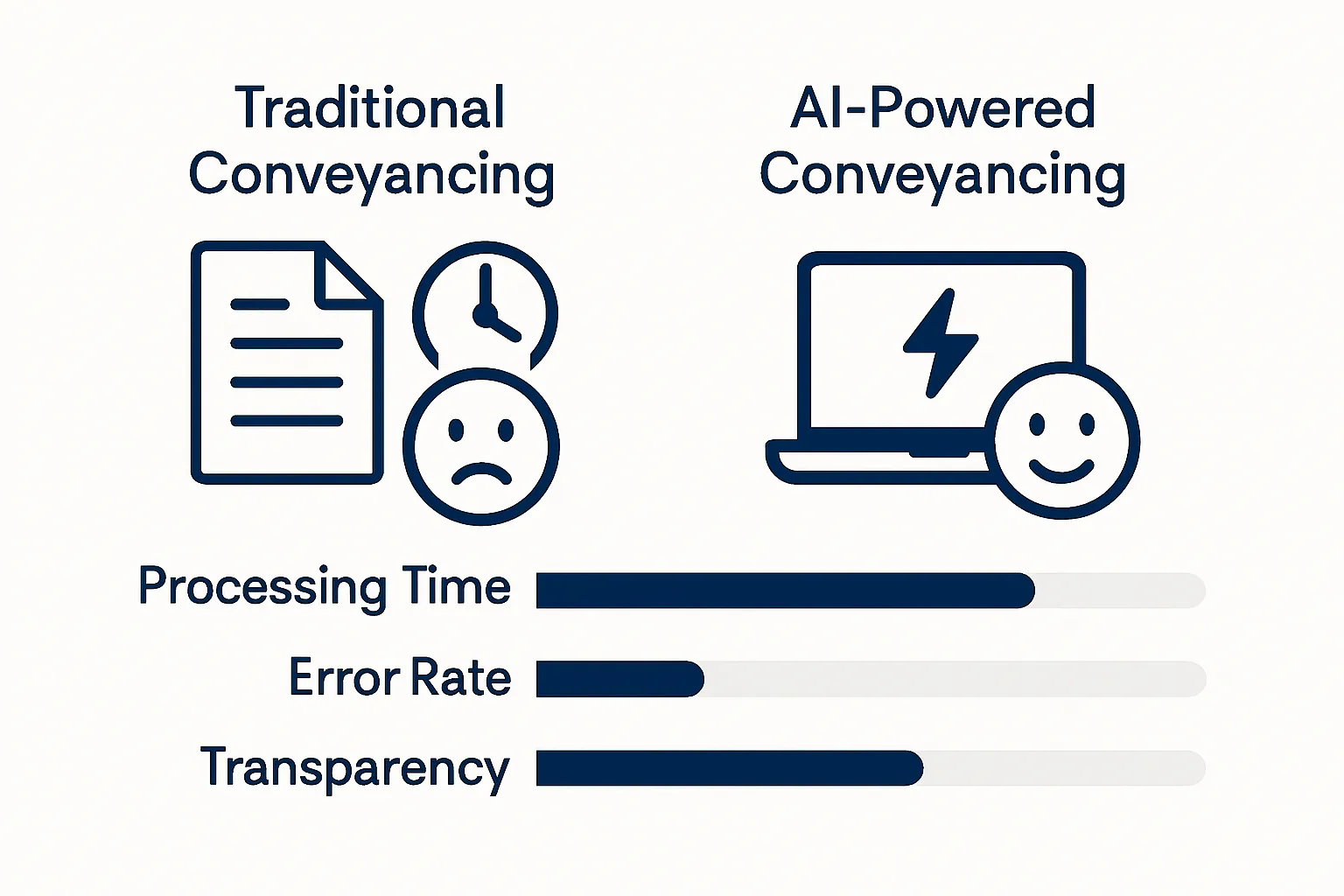Property transactions are notorious for their endless paperwork and long delays. Yet now, AI can slash weeks off the processing time and dramatically cut out mistakes that cost thousands. The shock is that these intelligent systems do not replace your solicitor, they actually make them far sharper and faster—giving humans more time to focus on the subtle details no computer can catch.
Table of Contents
- What Is Conveyancing AI And Its Purpose?
- The Importance Of AI In Modern Conveyancing Processes
- How Conveyancing AI Works: Key Components Explained
- Real-World Applications Of Conveyancing AI In Property Transactions
Quick Summary
| Takeaway | Explanation |
|---|---|
| Conveyancing AI speeds up property transactions | AI reduces weeks-long processes to days, enhancing efficiency in legal workflows. |
| AI minimizes human error in legal documents | Intelligent systems detect inconsistencies and mitigate costly mistakes during property transfers. |
| Real-time risk assessment is crucial | AI evaluates potential legal issues instantly, safeguarding clients and ensuring compliance. |
| Automated document processing enhances accuracy | Advanced algorithms generate legal paperwork with precision, ensuring regulatory standards are met. |
| Continuous learning improves AI’s effectiveness | Machine learning allows systems to adapt and refine risk detection based on previous transactions. |
What is Conveyancing AI and Its Purpose?
Conveyancing AI represents a transformative technological approach that leverages advanced algorithms and machine learning to streamline property transaction processes. By integrating sophisticated computational techniques, AI is reshaping how legal professionals handle complex property transfers, reducing manual workload and minimising potential human errors.
Understanding the Core Mechanics
At its fundamental level, conveyancing AI operates by processing vast amounts of legal data and property information with remarkable speed and precision. Online conveyancing services now employ intelligent systems capable of:
- Automated document analysis and verification
- Real-time risk assessment for property transactions
- Predictive insights into potential legal complications
- Instant generation of standardised legal documentation
The primary purpose of conveyancing AI is not to replace human legal professionals but to augment their capabilities, enabling them to work more efficiently and accurately. By handling repetitive administrative tasks, AI allows solicitors to focus on nuanced legal interpretations and client relationships.
Key Benefits of AI Integration
The introduction of AI into conveyancing brings significant advantages for both legal professionals and property transaction participants. Technological innovations now enable faster processing times, reducing traditional weeks-long procedures to potentially just days. The system can cross-reference multiple databases simultaneously, flagging potential issues before they become problematic and providing a more transparent, streamlined experience for all parties involved.
Moreover, AI-driven conveyancing solutions can dramatically reduce human error, a critical consideration in legal property transfers where mistakes can be costly. By implementing intelligent verification protocols and machine learning algorithms, these systems can detect inconsistencies or potential legal risks with greater accuracy than traditional manual review processes.
The Importance of AI in Modern Conveyancing Processes
AI technologies are fundamentally revolutionising the conveyancing landscape by addressing long-standing inefficiencies and transforming traditional legal workflows. The role of technology in modern conveyancing services highlights how intelligent systems are becoming crucial in streamlining property transactions.
Efficiency and Accuracy Improvements
Traditional conveyancing processes have been notoriously time-consuming and prone to human error. AI introduces unprecedented levels of precision and speed by:
- Automating repetitive documentation tasks
- Reducing potential human error in legal paperwork
- Accelerating document verification processes
- Enabling real-time data cross-referencing
These technological advancements mean that complex legal checks which previously took weeks can now be completed within hours, significantly reducing transaction timelines and potential bottlenecks in property transfers.
Risk Mitigation and Compliance
Intelligent AI systems are particularly powerful in identifying potential legal risks before they become problematic. By analysing extensive legal databases and historical property records, these technologies can flag potential issues such as ownership disputes, incomplete documentation, or regulatory non-compliance with remarkable accuracy.
Moreover, machine learning algorithms continuously improve their risk detection capabilities by learning from each transaction, creating a progressively more sophisticated compliance mechanism that adapts to evolving legal landscapes. This approach not only protects clients but also provides solicitors with comprehensive insights that might have been overlooked through traditional review methods.
How Conveyancing AI Works: Key Components Explained
Conveyancing AI operates through a sophisticated integration of multiple technological components designed to transform complex legal processes. Understanding the basics of conveyancing provides essential context for comprehending how these advanced systems function.
Machine Learning and Data Processing
Artificial intelligence in conveyancing leverages advanced machine learning algorithms to analyse and interpret vast amounts of legal documentation and property-related data. These intelligent systems are built on complex neural networks capable of:
- Recognising patterns across multiple legal documents
- Extracting relevant information with high precision
- Identifying potential anomalies or risks
- Comparing current transactions against historical legal records
The core mechanism involves training AI models on thousands of previous property transactions, enabling the system to develop increasingly nuanced understanding of legal requirements and potential complications.
Intelligent Document Processing
At the heart of conveyancing AI lies an advanced document processing engine that goes beyond simple text recognition. These systems employ natural language processing techniques to comprehend the contextual meaning of legal documents, not just their literal text. Sophisticated algorithms can now interpret complex legal language, automatically flagging potential issues such as incomplete information, inconsistent clauses, or regulatory non-compliance.
By continuously learning from each processed document, the AI refines its ability to understand subtle legal nuances, transforming raw documentation into actionable insights for legal professionals.
Below is a table summarising the key components of conveyancing AI, organising the main technological features and their specific functions as mentioned in the article.
| Component | Description | Key Function |
|---|---|---|
| Machine Learning Algorithms | Advanced data analysis tools built on neural networks | Pattern recognition and anomaly detection in legal documents |
| Data Processing | Automated handling of large volumes of property and legal information | Extraction and comparison of relevant transaction data |
| Intelligent Document Processing | Natural language processing to interpret legal texts | Contextual document analysis and flagging of risky clauses |
| Real-Time Risk Assessment | Continuous evaluation using updated legal and property data | Immediate identification of potential issues or compliance risks |
| Automated Documentation Generation | Algorithm-based creation of legal paperwork | Drafting, reviewing, and validating property documents |
| Continuous Learning | Adaptive improvement through exposure to historical transaction data | Refinement of risk detection and compliance protocols |
Real-World Applications of Conveyancing AI in Property Transactions
AI technologies are transforming conveyancing from a traditionally paper-intensive process to a streamlined, intelligent workflow. The future of conveyancing trends and innovations reveals how these technological advancements are reshaping property transactions.
Property Search and Risk Assessment
Conveyancing AI excels in comprehensive property risk evaluation, providing unprecedented insights during transaction assessments. Intelligent systems can now:
- Instantly analyse historical property ownership records
- Cross-reference multiple legal databases simultaneously
- Detect potential boundary disputes or planning restrictions
- Identify environmental risk factors affecting property value
These advanced capabilities mean solicitors can now provide clients with more thorough and rapid assessments, significantly reducing the time traditionally spent on manual research and verification processes.
Automated Documentation and Compliance
AI-powered platforms are revolutionising legal documentation management by automating complex compliance checks and generating precise legal paperwork. Machine learning algorithms can now draft, review, and validate legal documents with remarkable accuracy, ensuring that every aspect of the property transaction meets regulatory requirements.
By integrating intelligent document processing, these systems eliminate common human errors, reduce processing times, and provide a more transparent, efficient pathway for property transactions. The technology learns from each processed document, continuously improving its accuracy and predictive capabilities across different types of property transfers.
This table compares the traditional conveyancing process to the AI-driven approach, highlighting major differences in speed, accuracy, risk management, and compliance as discussed throughout the article.
| Feature/Aspect | Traditional Conveyancing | Conveyancing AI-Powered Process |
|---|---|---|
| Processing Speed | Typically takes several weeks | Reduces to days or even hours |
| Human Error Risk | Higher risk due to manual checks | Minimised by automated, intelligent verification |
| Document Verification | Manual and time-consuming | Automated and rapid |
| Risk Assessment | Retrospective, may overlook anomalies | Real-time, thorough, and adaptive |
| Compliance Management | Requires manual cross-referencing regulations | Automated, up-to-date, and learning from past cases |
| Transparency | Limited visibility for clients | Enhanced through instant updates and cross-checks |
Ready to Experience AI-Powered Conveyancing?
The article highlights a common frustration for buyers and sellers: slow, error-prone property transactions filled with paperwork and uncertainty. Conveyancing AI is transforming this field, taking away the headaches caused by manual document checks and outdated processes. If you want to benefit from fewer delays, enhanced accuracy, and a smoother journey from start to finish, embrace the technology that is shaping the future of property transfers.
Why wait for traditional methods to catch up? Discover how conveyancing AI solutions can put you ahead in your next move. Take the first step now with an instant, fixed-fee quote from Conveyancing-Solicitor.co.uk and unlock premium help from trusted, five-star legal experts. Let smarter technology and expert support simplify your property transaction today. Visit Conveyancing-Solicitor.co.uk to get started.
Frequently Asked Questions
What is Conveyancing AI?
Conveyancing AI is a technological approach that uses advanced algorithms and machine learning to streamline property transaction processes, making them more efficient and accurate.
How does Conveyancing AI improve the property transaction process?
Conveyancing AI improves the process by automating document analysis, conducting real-time risk assessments, generating legal documentation, and reducing manual workloads, thereby speeding up transactions and minimizing errors.
What are the key benefits of using Conveyancing AI in property transactions?
The key benefits include faster processing times, reduced human error, enhanced risk mitigation, and improved accuracy in legal compliance, leading to a more efficient transaction experience for both legal professionals and clients.
How does machine learning contribute to Conveyancing AI?
Machine learning enables Conveyancing AI to analyse vast amounts of legal data, recognise patterns, identify anomalies, and improve its accuracy with each transaction by learning from past experiences.
Recommended
- The Role of Conveyancers in Property Transactions – Conveyancing Solicitor
- Understanding the Basics of Conveyancing – Conveyancing Solicitor
- The Role of Technology in Modern Conveyancing Services – Conveyancing Solicitor
- Understanding the Role of a Conveyancer in Property Transactions – Conveyancing Solicitor

